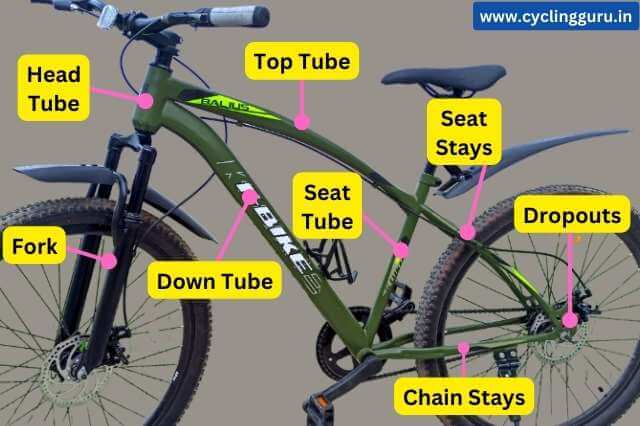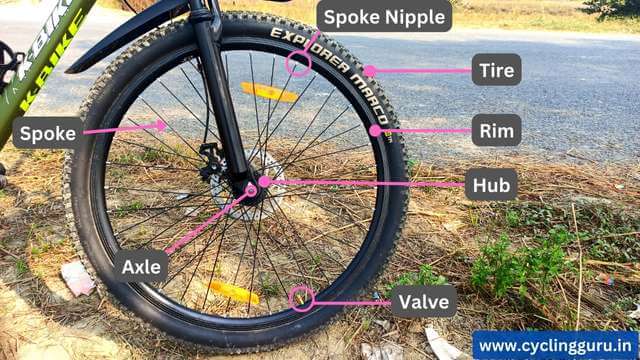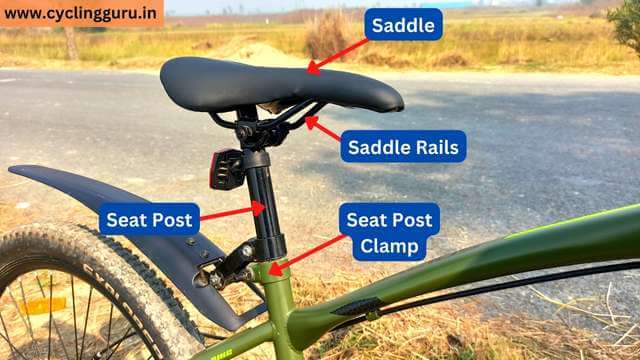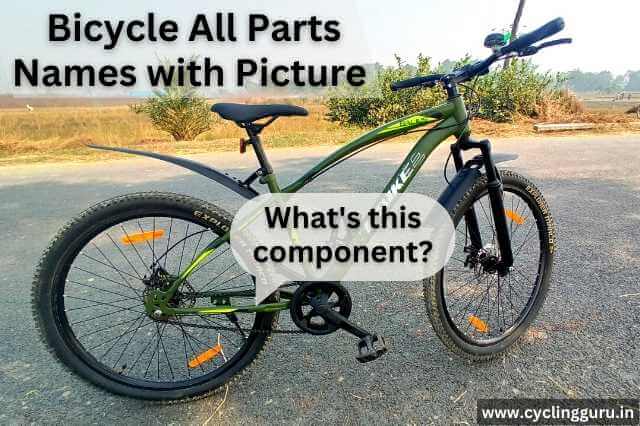A Bicycle is assembled with a lot of different parts such as a frame, rims, tyres, brakes, handlebar, chain, fork and so on. But do you know the name of each and every part of a bicycle and its function?
Whether you are a beginner cyclist or a professional one, a Basic understanding of bicycle parts names and their functions is very important for getting good results and performance out of your bike.
A basic understanding of bicycle anatomy will make you aware of your bicycle performance and maintenance requirements accordingly.
In this blog article we have covered almost everything about cycle parts names with pictures, how each component of a bicycle works, and some important faqs at the end.
Let’s find out the names of bicycle components and their functions.
Bicycle Parts Names and Their Functions: Explained
Here is a detailed description of the names of bicycle parts and their functions explained for the convenience of everyone.
1. Name of bicycle frame parts (Bicycle frame anatomy)

The bike’s sturdy core is its frame. Bicycle frames are made using Steel, aluminium, alloy, carbon fibre and titanium. Steel, aluminium and alloy are heavier than carbon fibre and titanium, therefore they are used in low-end bikes.
However, Carbon fibre and titanium are very lightweight and thus they are mostly used in high-end bicycles. Frames must be stiff, light, and sturdy. The frame and fork are united to form a frameset.
The most popular type of frame is a diamond frame (step-over frame) which consists of six tubes arranged into two joined triangles. And another type of frame is step through which is mostly used in ladies’ bicycles, where a top tube is not available.
a). Top Tube
When mounting the bike, you walk over the top tube, also referred to as the crossbar which joints the head tube to the seat tube. It usually follows a straight line (parallel to the ground), however, it could sometimes be slightly slanted.
The length of the top tube of a bicycle frame decides your riding position while cycling, a longer length will provide more aerodynamics and a shorter length provides a more comfortable riding position which means an upright riding position.
b). Head Tube
This is the smallest and foremost tube of a bicycle frame as it joins the handlebars and wheel fork. It has a headset, which enables us to use the handlebars to steer the front wheel freely on two internal sets of bearings.
c). Down Tube
The down tube is the lengthy tube that connects the head tube, which is located immediately below the handlebars, to the pedals. Typically, it makes up the bulkiest region of the frame. The water bottle cage and the bike manufacturer’s emblem are located there. Sometimes they are slightly thicker than the other tubes.
d). Seat Tube
The seat tube descends to the pedals (bottom bracket) from the area under the saddle. And this length is called frame size. The top of the seat tube receives the seat post and chainstays to the down tube.
The upper part of the seat tube houses the seat post, and it is tightened using nuts bolts or quick-release bolts. The angle of a seat tube is unique in different types of bikes. You will notice seat tubes with a steep angle in road bikes and a slack angle in hybrid bikes.
e). Seat Stays
The seat stays are two smaller tubes that extend from the saddle’s base all the way to the rear hub or the back wheel. A “rear drop out” marks the end of each seat stay. Additionally, each rear drop-out is attached to one side of the rear wheel’s axle.
f). Chain Stays
The chain stays are two narrower tubes that extend from each side of the pedals to either side of the back wheel parallel to the ground. Chain stays are so named because they run parallel to the bike chain.
g). Forks
The component of a bicycle that joins the front wheel to the frame is called the fork. From the steerer tube’s bottom, two blades extend down either side of the wheel. These blades’ dropouts allow them to be attached to the front wheel axle. The fork crown, which is located directly below the steerer tube, is where these two blades come together above the front wheel. The stem and head tube are connected via the steerer tube, which is a component of the bicycle fork.
Currently, bicycles have two types of forks, rigid and suspension. Rigid forks are good for paved roads and flat surfaces therefore most road bikes and city bikes have a rigid fork for more speed and low weight.
However, suspension forks are heavy and mostly used in mountain bikes, hybrid bikes, and electric bikes in order to absorb more shock. But a lot of new riders think “Are suspensions on a hybrid bike truly useless?” – Read and comment your thoughts
2. Frontal Components of a Bicycle

The majority of a bike’s front-end parts contribute to how it handles and is controlled with all of the navigation and speed control components located here. Let’s see what is the name of a bicycle’s frontal parts:
a). Headset
The headset is a collection of parts that connects the frame with the wheel fork and sits inside the fork steerer tube (one above and below the head tube). A bicycle headset has two cups with bearings so that the handlebar turns smoothly.
The rotation of a handlebar causes the front wheel to turn, thanks to bearings in the headset, which allows for this smooth turn. Integrated systems and threadless headsets are the most common headsets.
b). Stem
The stem is one of the bicycle’s components that joins the fork’s steerer tube to a handlebar. This means when you move the handlebar, the wheel of the bike move. In essence, it is the portion of the head tube that protrudes forward. The handlebars pass through the stem’s tip.
There are multiple screws in most modern stems, making it possible to remove your handlebars without removing the bar tape, brakes, or gear shifter.
c). Handlebars
The direction of a bicycle is controlled by a handlebar, therefore it is considered one of the significant parts of the bicycle’s anatomy. The handlebar is connected to the stem and the other part of the stem is connected to the fork’s steerer which is inside the head tube of a cycle frame.
When it comes to the shape of a handlebar, Urban, hybrid, and mountain bikes all have flat handlebars. Road bikes have drop handlebars. But there are also a lot of other styles of handlebars for different types of bikes.
d). Brake Levers
Brake levers are found on the handlebars at both ends, which you squeeze/pull using your fingers to slow down the bicycle are called brake levers. In other words, Brake levers are used to stop the bicycle or to apply the brakes.
As the brake lever is squeezed, the brake cable is pulled tight, causing the brake calliper to pinch either the rim of a wheel or the disc rotor, which slows or disables the bike.
Brake levers are generally made from plastics in low-end bikes and aluminium or alloy brake levers are used in high-end premium bicycles. They can occasionally be paired with a gear shifter to form a “brake shifter,” also called a “brifter.”
e). Brakes (Rim vs Disc)
Brakes are a very important component of a bicycle, as it stops the bicycle instantly or reduces the speed accordingly.
There are three types of brakes in a bicycle: Hub brakes, Rim brakes and Disc brakes.
The Hub braking system is the traditional one and is rarely used in the latest bicycles.
When it comes to Rim Brakes, it is called rim brakes because it is applied to the bicycle rims and stops the rims. it is the most popular because it is very cheap, lightweight has no maintenance cost, and is powerful as well. But it does not work properly when it’s raining or the rims are wet. It has 3 main types such as calliper, v brakes and cantilever brakes.
Then Disc brakes come into the picture, A unique metal disc rotor is fastened to the wheel hub which is stopped by callipers. And it does not stop the rims. Therefore, They are more durable than rim brakes and perform better in wet circumstances too.
Now, the majority of bicycles are equipped with disc brakes because it is always efficient.
f). Headset Cap
Bicycle parts known as headset caps are used to preload (exert pressure on) the headset. They are also known as top caps and stem caps. Prior to tightening the stem, bike top caps are placed on top of the fork steerer tube and tightened until there is no play or movement in the headset. The stem can be adjusted and tightened when the stem cap is properly tightened.
Related: History of the Bicycle: A timeline – Learn how bicycles evolved since 1817
g). Bar-End Plugs
Small plugs that slide into the end of your handlebars are known as bar-end plugs or handlebar plugs. To avoid injuries in the event of a fall or crash, plugs are inserted. Open-end handlebars have sharp edges that are easily able to pierce the skin. In several fatal bicycle accidents, open-ended handlebars tore through the abdomens of the victims, injuring crucial organs.
h). Handlebar Grips & Bar Tape
Grips and bar tape are used to provide a firm grip for better control. Generally, rubber and leather grips are used in mountain bikes, BMX, Hybrid bikes and other types of cycles. Make sure to know these 21+ different types of bicycles.
However, Bar tapes are used in road bikes for better holding control along with cushioning and stability without any pressure because they are made from textured rubber. It eliminated the vibration that the rigid fork feels.
Bar tapes are good for long rides, such types of tapes are also used in badminton rackets for excellent cushioning and grip.
i). Brake Cable
In mechanical braking systems, brake wires are essential for managing your bike’s speed. Mechanical brake wires, as you may already be aware, are enclosed in an exterior casing that protects them while allowing them free movement inside. Brake cables typically have a diameter of 1.5 to 1.6 mm and varying heads to accommodate different cycling disciplines.
3. Parts of a Cycle Wheel

You must have ridden/seen a bicycle wheel. But do you know the name of each and every part of a bicycle wheel?
Well, a bike wheel is made up of several significant components. Information on each component of a bicycle wheel is provided below.
a). Hub
The bicycle wheel’s hub is located at the centre of the wheel, it has bearings (inside) which allow the wheels to rotate smoothly. And This is the same for the front and rear wheels of a bicycle.
The axle, bearings, and hub shell make up its three components. The outer component to which the spokes are attached is the hub shell. The bar that sticks out on either side and is attached to the frame is the axle. Additionally, bearings are positioned between the axle and the shell to permit the shell to freely rotate about the axle.
b). Rims
The metal ring that surrounds the outside of the wheel is known as the rim. Rims were once constructed of steel, but since the 1980s, they are typically composed of an alloy of aluminium and magnesium (mag wheels).
Rims come in different sizes and shapes. It has holes at a specified distance for spokes and spoke nipples and then tyres are attached to the bicycle rims, and tubes are placed inside the tyres.
Road bikes have thin rims. Whereas mountain bikes have thick and strong rims. The majority of bikes have dual-wall alloy rims as they are lightweight, strong, and provide good speed.
There is a smooth side surface for the brake pads to grip if they are to be utilised with rim brakes.
c). Spokes
It is a thin metal rod which connects the hub to the rim of a bicycle. Spokes hold the entire weight of the bicycle and the riders so they must be installed and tensioned properly.
Properly tensioned spokes provide better performance and speed otherwise it may change the shape of the wheel or damage the rim.
Nipple nuts are used to regulate the tension and are located where the spokes meet the rim.
d). Valves
You may fill your tyres by using the air inlets on a bike wheel. Although there have always been many different types of valves, the two most used nowadays are Schrader and Presta valves.
The identical valves used in motorcycle and automobile tyres are called Schrader valves. The spring-loaded pin in the middle of the valve must be lowered in order to inflate a Schrader tyre. The valve opens when this pin is depressed, allowing the tyre to be inflated.
Road bikes are the primary users of Presta valves. Presta valves are more streamlined than Schrader valves and tightly seal with just air pressure. Because of this, they may employ a simple valve without adding weight.
A valve that protrudes through the hole in the wheel rim adds or releases air from the inner tube. The two valve types that are most frequently used are Schrader and Presta. In automobiles and motorcycles, Schrader valves are also utilised. Presta valves, however, are only utilised with bicycles.
e). Spoke Nipples
Nipples on the end of the spoke are tightened after passing through the wheel rim. The spoke’s stress rises when the spoke nipple is tightened, which also raises the hub’s tension. Spokes are typically provided with matching threaded nipples since spokes and spoke nipples must have the same thread.
f). Tyres
The tyres of a bicycle makes the contact with the ground while it moves. Tyres have different sizes according to rim and bike type, it is attached to the rims.
Road bikes have thin tyres (tubular tyres) as compared to mountain bikes. MTBs have wide tires (clincher tyres) for more traction on roads and rough terrain. Tyres and tubes make the ride comfortable by absorbing shock.
- Related: 26-Inch Bicycle Wheel Size for What Size Person (Size Chart Included) – A detailed explanation!
Tyres are made of linen that has been impregnated with rubber and has an outside tread layer of thicker rubber. The tyre is placed at the top of an inner tube filled with air to provide suspension.
g). Tube
The tube is one of the important parts of a bicycle wheel. It is placed inside a clincher tyre of a bicycle and then air is filled through valves (discussed above) by using an air pump.
4. Bicycle Drivetrain Components Explained

The most common parts of a bicycle drivetrain are the chain, pedals and derailleur. You must have heard these names. But It is not limited to these parts only. Below is an explanation of some more important parts of a cycle drivetrain:
a). Chainset or Crankset
Your legs push on the crankset, which is a part of the bicycle, to turn the back wheel. It consists of the crank arms and the chainrings, around which the chain rotates (to which the pedals attach).
The bike’s front gears are the chainrings. There is only one chain ring on a non-geared bicycle. There could be up to three on a geared bicycle. The bottom bracket of the frame, the chain of the back wheel, and the pedals, all are connected to the crankset.
b). Pedals
Your feet and the bike are connected by rotating devices called the pedals. To proceed, you press down on them. There are essentially two types of pedals: clip-in pedals and flat/platform pedals, which you use with specific shoes with cleats in the soles to more securely attach them to the pedal.
Related Posts:
- Top 10 Best Gear Cycle Brands in India – With Price, Pros & Cons!
- Top 5 Best Gear Cycles under 15000 in India – Our Recommendations!
c). Bottom Bracket
The area of the bicycle where the crank arms revolve is the bottom bracket. It is made up of bearings and a spindle to which the crankset is attached (which allows the smooth rotation of the spindle). At the base of the frame, the bottom bracket slides into the bottom bracket shell.
d). Chain
A chain is one of the important components of a bicycle drivetrain which is attached to the chainrings at the front end and the cassettes at the back. It transfers the rotation of the crankset to the rear wheel to rotate in the same direction and this process is performed by pedalling.
Your legs’ force is transferred to the back wheel by the bike chain. It loops around the crankset’s chainrings, the chain stay’s length, and the cassette’s sprockets in the back wheel.
Generally, the life of a chain lies between 3000 to 4000 km (depending upon the usage and maintenance). You should keep your bike chain cleaned and lubed to perform better with less effort.
These chains are shifted in a geared bike by using derailleurs and shifters. You should know how to shift gears otherwise, you may damage your bike chain.
e). Front Derailleur
The front derailleur is a significant part of a geared bicycle’s anatomy. It allows you to shift the gears up or down on the bicycle chainrings in order to reduce/increase the pedalling difficulty.
The front derailleur is a part of a geared bicycle with more than one chainring and it is located at the bottom of the seat tube of a bike frame. Gears are shifted by using the gear shifter which is located at the handlebar (left or right).
f). Rear Derailleur
When you change gears, the rear derailleur on your bicycle moves the chain from one cassette cog to another on the back wheel. It functions in tandem with the jockey wheel. Rear derailleurs are found in only geared bicycles, Shimano tourney and microshift mezzo are two popular rear derailleurs which are used in average bicycles.
g). Cassette or Cogset
The cassette is a collection of cogs (or sprockets) of various sizes that are fastened to the hub of the back wheel. The bicycle’s back gears are the cassette cogs. There will only be one cog if your bike has no gears.
h). Jockey Wheel or Tension Pully
Jockey wheels are found only in the rear derailleur of a geared bicycle. One is visible which maintains the tension with the chainrings and another one is inside the derailleur which shifts the chain from one cog to another.
As you shift gears, the jockey wheel keeps the chain taut and keeps it moving smoothly.
5. Names of Bicycle Seat Parts

The seat parts of a bicycle are fixed on the seat tube of a bike frame. It is the place where a rider sits comfortably and rides the bicycle, it also has many different parts that you might be unaware of. Let’s see what are the seat parts of bicycle and their functions:
a). Saddle or Seat of a Bicycle
A bicycle saddle is also known as a cycle seat in India. You sit on this while pedalling or cycling. Bicycle saddles come in a wide range of sizes and styles. Wide saddles are mostly found in ladies’ bicycles for extra cushioning and comfort.
Whereas, Narrow width saddles are used in road bikes, racing bikes, and in mountain bicycles to avoid thigh rubbing.
b). Seat Post
The seat post is also known as seat pillars, seat pins, and saddle pillars in different countries. So, it is a tube which is put inside the bicycle seat tube and is tightened with a clamp.
It increases or decreases the saddle height by putting this inside or outside of the seat tube. An overextended Seatpost is damaged easily damaged so avoid doing this.
c). Saddle Rails
The two parallel rails that go along the bottom of your bike seat are called saddle rails. These rails, which attach to the top of the seat post, can be constructed from a variety of substances. There are measures for fore and aft on the saddle rails. These are used to establish proper saddle placement.
d). Seat Post Clamp
The seat post clamp is located at the top of the seat tube of the bicycle frame. The seat post is held in position by these clamps, which are metal bands or collars that tighten the top of the seat tube.
Frequently Asked Questions on The Bicycle Anatomy Guide
Q1. What is the most important part of a bicycle?
According to me, the frame is the most important part of a bicycle because all the parts and components are fixed and attached to the frame. It connects the entire bicycle and gives the shape of a bike, without it, bicycle parts are useless.
Q2. What are the 5 main parts of the bike or bicycle?
Well, each and every part of a bike is important if you don’t know then read above. But, Frame, Wheels, Handlebar, drivetrain, and saddle are the five major parts of a bicycle to move forward.
Q3. What is a bicycle axle?
An axle of a bicycle is a component that allows the wheel’s hub to rotate smoothly. Generally, it is round and threaded, and it is made of solid metal.
Q4. What’s the most expensive part of a bicycle?
According to me, the rider is the most expensive part of a bicycle even if it doesn’t have a price tag, it’s priceless. When it comes to components, then it’s the frame of a bicycle. Carbon fibre frames are the most expensive part of a bike.
Conclusion on the Names of Bicycle Components
I hope you would remember each and every bicycle parts names and its role in a cycle. You will easily find out which part of your bicycle needs to be replaced or repaired when not working properly.
That’s it about the various parts of a bicycle and their important functions. I have divided the bicycle parts name list with pictures into five sections accordingly. It is really interesting to learn more about such things, to which we normally don’t pay attention.
The best thing about the bicycle anatomy guide is that it includes each and every function of the parts mentioned in depth, which provides the best understanding to the readers about the bicycle’s anatomy with pictures.
Do let us know in the comment section below, which part of the bicycle you were not aware of or didn’t know the name of and if we have missed any. Stay tuned!
Keep Pedalling!

